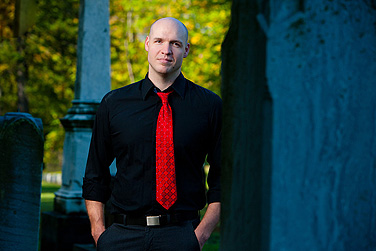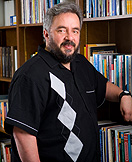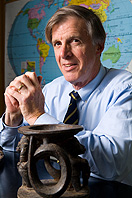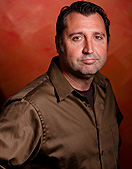News
Why we create monsters

PhD candidate John Edgar Browning conducts research on vampires. Photo: DOUGLAS LEVERE
-
 Print
Print -
 Comments
(1)
Comments
(1)
-

David Schmid studies cultural monstrosities. Photo: DOUGLAS LEVERE

Phillips Stevens Jr. is a scholar of witchcraft. Photo: DOUGLAS LEVERE

David Castillo specializes in the Baroque era. Photo: DOUGLAS LEVERE
Monsters that scare us—vampires, zombies, witches—help us cope with what we dread most in life. Fear of the monstrous has brought communities and cultures together over the centuries and serves us as well today as it did in the Dark Ages.
Several UB faculty members specialize in what many cultures find horrible and terrifying. Their interests range from satanic practice, black magic and cultural monstrosities (like serial killers) to “real” and imagined vampires and zombies, as well as the bizarre Spanish gothic period in which our fascination with the utterly horrible is grounded. One expert even includes greedy bankers and environmentally destructive corporations among the monsters of our time.
Yes, Virginia, there are ‘real’ vampires
John Edgar Browning, an Arthur A. Schomburg Fellow and PhD candidate in the Department of American Studies, has written several books and conducts research on the vampire. He specializes in the Dracula figure in film, literature, television and popular culture.
“Vampires and monsters—they’re just us,” Browning says. “They’re what we aspire to be, what we’re told to hate most about ourselves, what we secretly yearn for, but shouldn’t.”
Browning is the author of several books, including “Draculas, Vampires and Other Undead Forms,” “Dracula in Visual Media: Film, Television, Comic Book and Electronic Game Appearances, 1921-2010” and “Speaking of Monsters: A Teratological Anthology.” He has conducted extensive field work in New Orleans, where he uncovered a subculture of “real” vampires: people who drink blood or absorb what they call “psychic energy.”
Contemporary vampires may be sympathetic or even figures of humor or mockery. Take Sesame Street’s “The Count,” who represents a variation on the cultural belief that one way to disarm vampires is to make them count something because they can’t stop counting.
“The vampire of today’s popular culture may or may not inspire terror,” Browning says. “He or she may provoke empathy or pathos, forcing us to recognize its monstrosity as our own, to embrace what once we were taught to loathe.”
Watch a video of Browning discussing his work.
The monsters we don’t recognize
David Schmid, professor of English, focuses on cultural monstrosities—those among us whom we perceive as “monsters” and the role they play in our self-perception as individual and social beings. Although Schmid’s initial work in this field focused on the serial killer as an American popular-culture figure, he also studies how society safely represents and addresses the anxieties of our time through the use of other monsters, such as zombies and vampires.
“The monsters I’m most interested in are the ones that exist in plain sight,” Schmid says. “Sure, I write about the traditional Halloween and pop culture fare—zombies, vampires and so on—but I never want to lose sight of the fact that the most distinctive and numerous monsters in any culture are the ones that we don’t immediately recognize.
“I conduct research on killers and their place in our cultural imagination,” he says, “but I also want to extend that focus to other monstrous figures and institutions: those whose apparent normality makes them no less destructive and murderous—the abusers at Abu Ghraib, the banks that are destroying lives while reaping record profits and the corporations that are poisoning the planet for their bottom line.”
Schmid is the author of “Natural Born Celebrities: Serial Killers in American Culture”; “True Crime,” a companion to crime fiction; “The Devil You Know: Dexter and the ‘Goodness’ of American Serial Killing”; and books on noir novels, murderabilia and murder culture.
The evil witch
Associate professor and director of undergraduate studies in the Department of Anthropology, Phillips Stevens Jr.’s research and publications embrace works on spirits and spirit possession, Satanism, magic, sorcery, witchcraft, voodoo and deities of various cultures, and West African spiritual practice.
He has a special interest in the evil witch—not to be confused with modern pagans, like wiccans, who call themselves witches and are emphatically not evil. Although associated with pre-Christian Western culture, he says, the belief in witches continues to exist in societies throughout the world.
Stevens calls witches “a distillation or an articulation of many forms of cultural monstrosity, including, but not limited to, vampirism, incest, child sexual molestation, bloody murder and cannibalism—repugnant behaviors that viscerally disgust people.”
The evil witch, he says, is the prototypical, nefarious ‘other,’ “the focus of the original conspiracy theory. It causes whatever havoc it can in human society, from individual misfortune to mass epidemic, to stealing children from their beds and flying with them to meetings of witches, called the ‘sabbath’ in medieval European folklore.”
Where does our fascination with the horrible come from?
David Castillo, associate professor and chair of the Department of Romance Languages and Literatures, says the historical roots of horror in the modern age lie in the Spanish baroque period, roughly 1600-1720, an era that produced unusually grotesque, terrifying and fantastic literature—not unlike the worst of what we read about online or in the tabloid press today.
Castillo’s latest book, “Baroque Horrors,” explores a lot of terrifying behavior, beliefs, places and people of that era rarely considered together. For instance, the young woman cemented up in the family home—by her family—who waited for six years, despite the stench, while worms and vermin did her in from the feet up.
Why do we love these tales of mutilation, mutation, monstrosity, murder and mayhem?
They offer “a way for us to understand our own modern fears and their monstrous offspring, and new ways to think about broad questions of political history and relate them to the modern age,” Castillo says.

Reader Comments
paul holsberger says:
Interesting read. In my opinion, people shoudl stop fearing vampires or ghosts and instead start worrying about the "real monsters." Like serial killers (jack the ripper, jeffery dhammer) or the nut cases that jst go around shooting people like the man that shot senator gifford earlier this year. They are the real monsters
Posted by paul holsberger, the real things that we shoudl be afraid of, 11/03/11